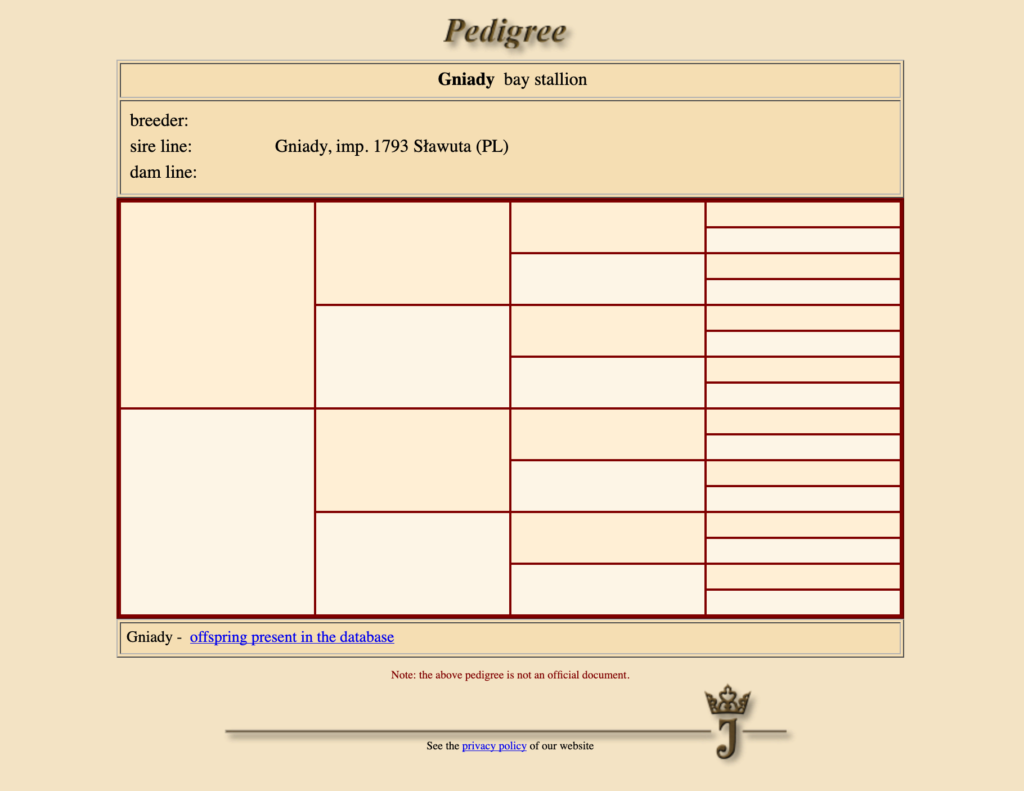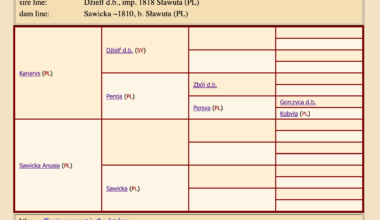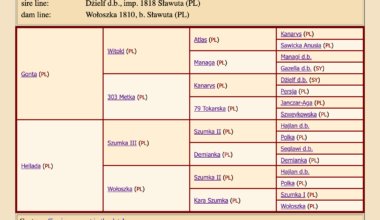Gniady in Polish and Russian means the color “bay.” This horse was a bay stallion purchased in Vienna by Eustachy Sanguszko. This stallion is primarily known as the sire of Polka who in turn was the dam of the stallion Szumka II. The Janow Podloski database, which is based on the Polish stud books also lists this horse as the sire of Szumka I. Gniady was not considered an Arab horse by the Sanguszkos.
Roman Sanguszko Sr.’s history of the stud in 1876 gives the following information: “The black Szumka II was the one that stood out the most from the Hajlan progeny, he came from the mare Polka. Polka was not a pure Arabian mare; her sire (Gniady) of a cherry-bay coat and bought in Vienna, Austria around the year 1790. It is even said that Prince Eustachy won the right to buy it by his brave and artful riding of it, as it was a very insidious horse.”
Roman Sanguszko Sr. repeated this in the Russian version of same text in 1876: “From the Keheilan’s offspring, the most famous was Shumka 2 out of the mare Polka. Polka was not a pureblood Arabian mare; her sire (Gniady) was a bay with dark-red coat and was bought in Vienna around 1790. Rumors were that Prince Eustachy was betting with someone and won the right to buy this horse, thanks to his horse-riding skills which helped him to overcome this angry and difficult horse.”
S. Wotowski in his article on the Sanguszko horses in 1891 gives us even more information on Gniady: “Prince Eustachy was staying in Vienna, when a stalwart stallion caught his eye at a horse trader’s. The Prince started haggling with the trader, who didn’t want to let off the price, and finally agreed to a discount on the condition that the Prince rode it himself from Leopoldstadt, where the stable was located, to Prater and back. The Prince, who had experience in the Napoleonic campaigns and was clearly a brave rider, accepted the offer and mounted the difficult horse to complete the ride. During this short ride the stallion was thrashing madly, chasing down horses and even people, eventually leading to the police chasing the horse and the prince. However, the trader kept his word and parted with the horse for the lower price. The provenance of the vicious horse is not sufficiently proven; it would appear that he was of the English race, but whether he was full-blood – it is hard to say. The said horse was used in the herd, however. From his daughter – named Polka, and the imported stallion Haylan – a colt was born – Szumka the 2nd, who later became a good stud.”
One complication with Wotowski’s account is it is prefaced with the words “a few years before sending Moszyński East” which indicates the time that Gniady was purchased and perhaps some of the context is not clear. Wotowski bases his article on a history of the stud written by Roman Sanguszko Sr. in 1865 and is not known to have survived. Perhaps Wotowski got the dates wrong as 2 primary sources written in Polish and Russian by Roman Sanguszko Sr. in 1876 indicates this horse was purchased by his father, Eustachy Sanguszko, in the 1790s in Vienna.
A stud report from 1799 lists a “dirty English chestnut from Prince E. Sanguszko” as the sire of the plurality of foals born at Chrestówka 1799. A bay horse could also be described by some as a dirty chestnut.


